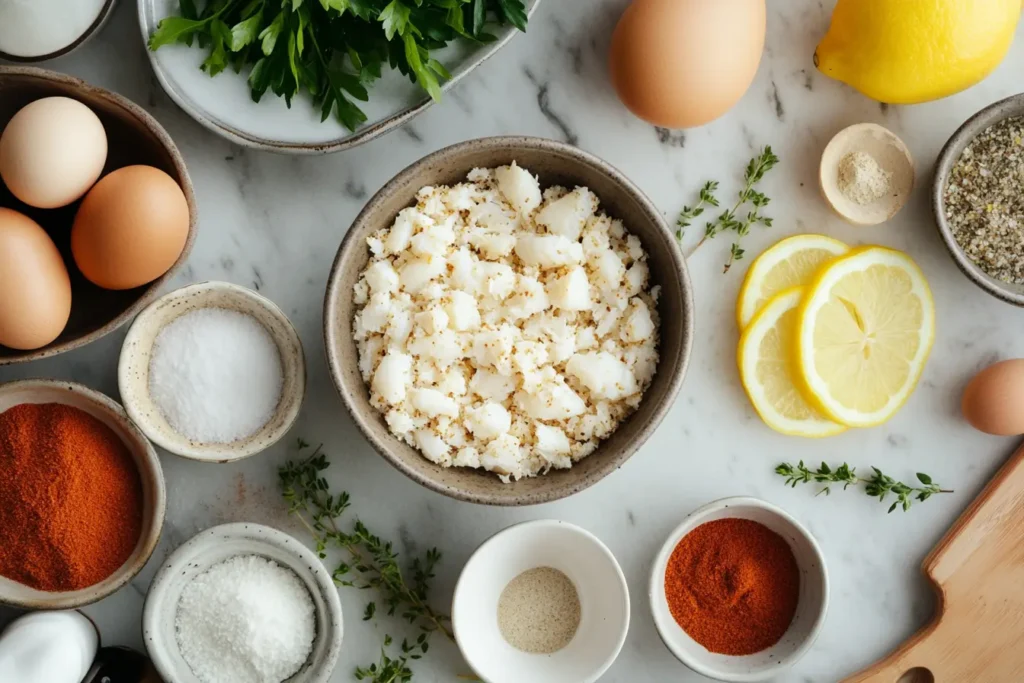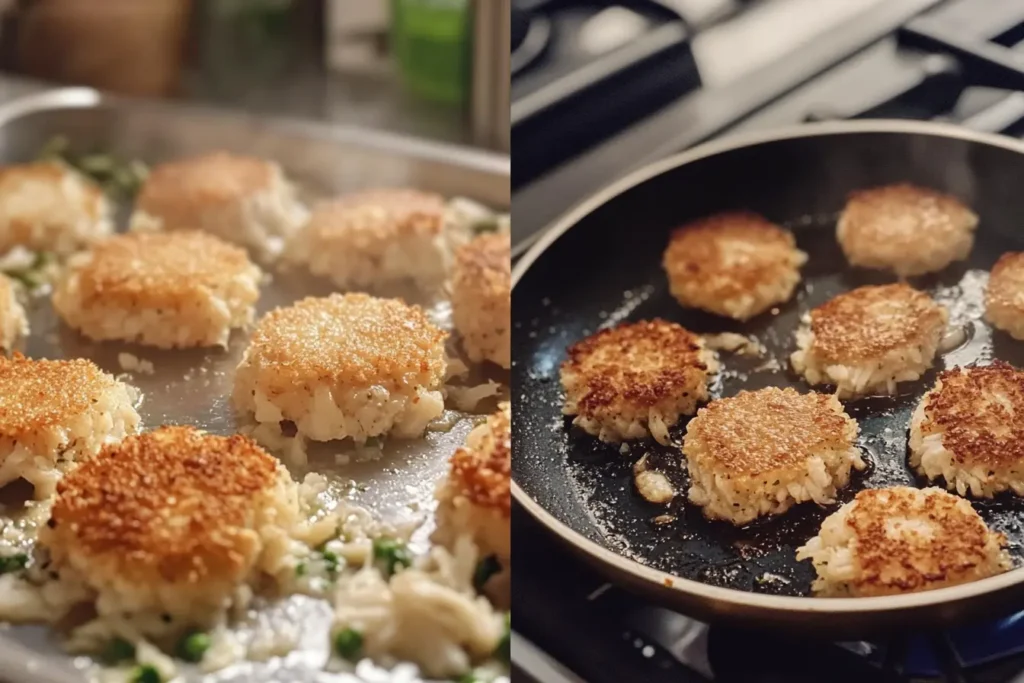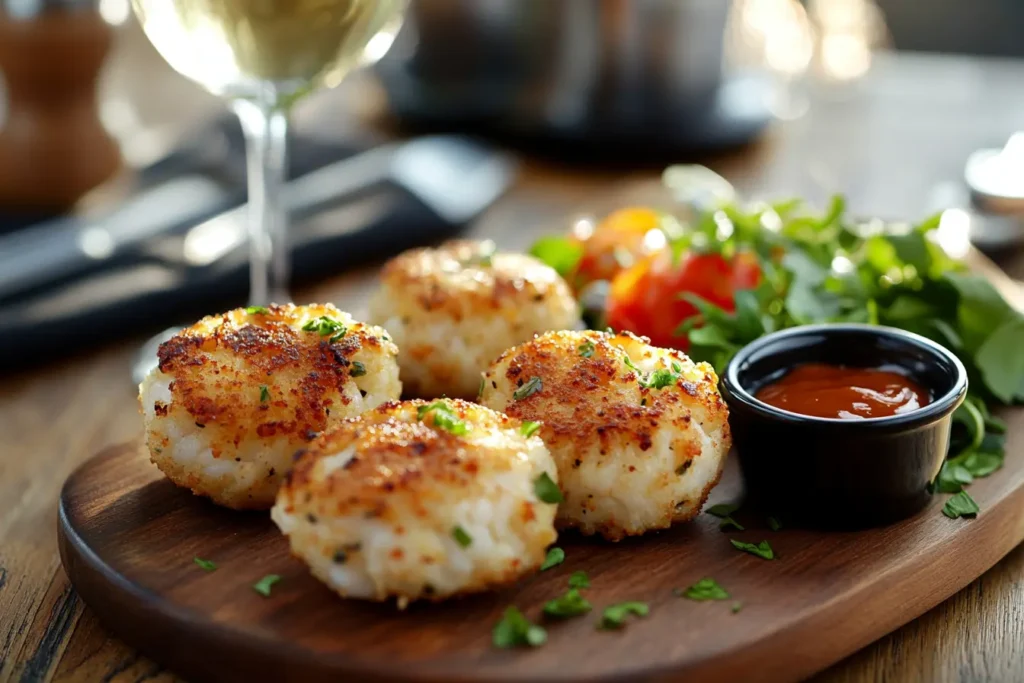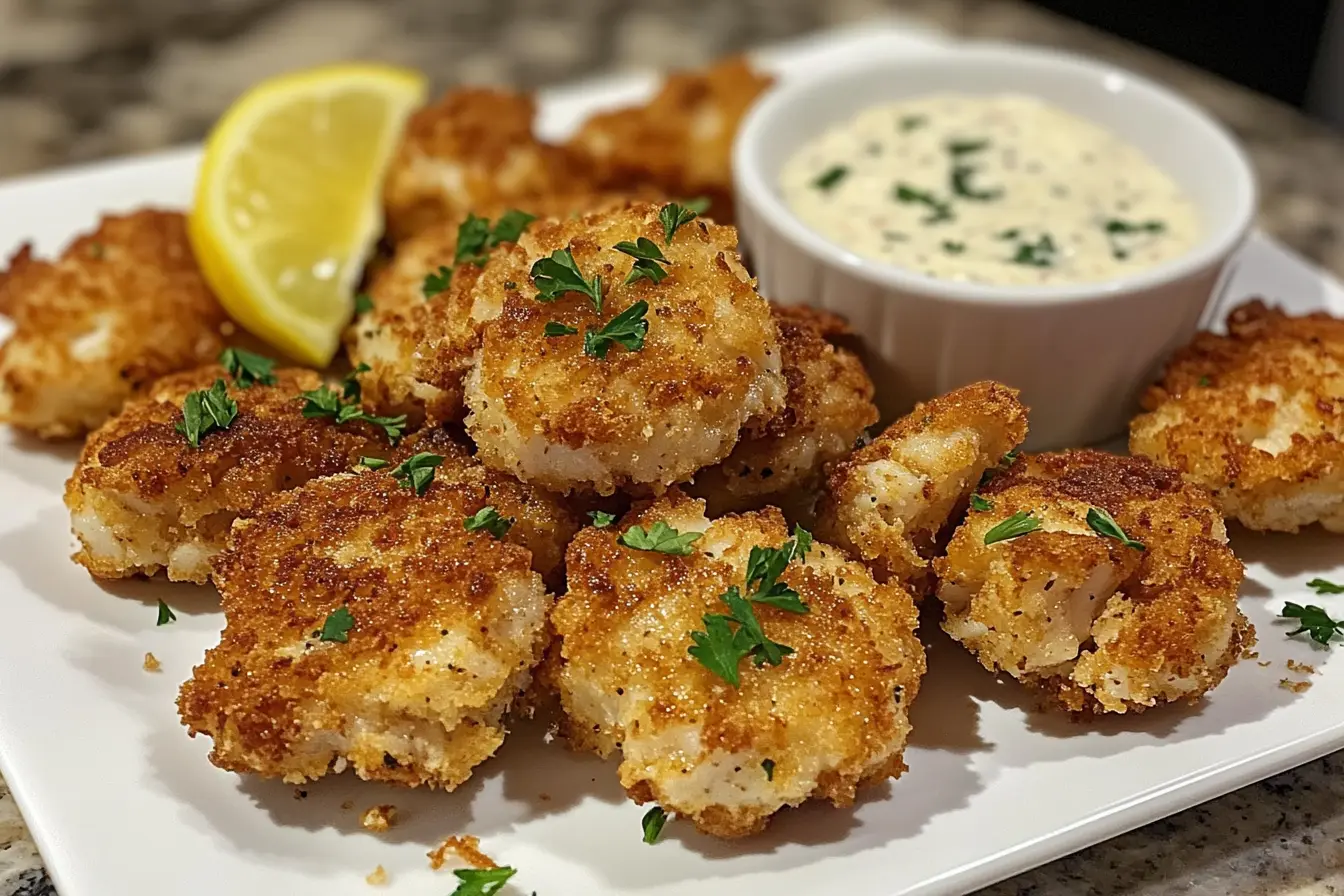Introduction
Mini crab cakes are more than just a savory bite-sized treat—they’re a culinary marvel with deep roots in seafood traditions. Perfect as appetizers or a light main course, these crispy, flavorful cakes have earned a special spot on dining tables everywhere. This article dives into everything you need to know about mini crab cakes: their origins, preparation, serving ideas, nutritional perks, and much more. From their delicious history to expert preparation tips, we’ll cover it all. So, let’s get cracking!
Mini Crab Cakes: A Delectable Seafood Delight
The Origin and History of Crab Cakes
The rich history of crab cakes dates back centuries, originating in the Chesapeake Bay area. This region, especially Maryland, is renowned for its abundant blue crab population, which forms the heart of authentic Maryland crab cakes. Early settlers in the area relied on this delicacy for sustenance, creating recipes with simple ingredients like crab meat, bread, and spices. Over time, the dish evolved, reflecting influences from global cuisines while maintaining its coastal essence.
Mini crab cakes offer a contemporary twist on the classic dish and are perfect for entertaining and snacking. Their bite-sized design adds convenience, making them a hit at parties. Additionally, their compact size allows every guest to enjoy the bold, savory flavor of fresh crab. As a result, they have become a go-to option for gatherings, balancing flavor, and convenience. Moreover, their versatility ensures they fit effortlessly into various menus, from casual appetizers to elegant seafood platters.
What Makes Mini Crab Cakes Unique?
Mini crab cakes shine because they perfectly balance texture and flavor while offering a smaller, more versatile format. Furthermore, their crispy, golden crust creates a delightful contrast with the tender, moist interior, enhancing every bite. Additionally, cooks can easily customize these bite-sized treats with unique seasonings or regional ingredients, which makes them even more appealing. As a result, mini crab cakes consistently deliver both charm and adaptability, making them a favorite for various occasions.
Moreover, their versatility is unparalleled—you can serve them as an appetizer, pair them with a salad, or even transform them into a hearty seafood slider. For those who love seafood, mini crab cakes are the ultimate indulgence!
Popular Variations Across Different Cuisines
While the classic Maryland-style crab cake remains the gold standard, global cuisines have given rise to creative variations. In Asian-inspired recipes, you might find ingredients like ginger, soy sauce, or chili added for a spicy kick. Southern styles often incorporate cornmeal for a unique texture, while Mediterranean versions may use herbs like dill and parsley for a refreshing twist.
Even within the U.S., regional adaptations abound—some focus on bold spices, while others lean into the natural sweetness of the crab. Each variation highlights the adaptability of mini crab cakes while respecting their seafood origins.
Linking to Additional Information
For a deeper dive into Maryland-style crab cakes, check out this excellent guide to traditional crab cake recipes. It provides a rich perspective on how this classic dish evolved and offers tips to create your own authentic version.
Ingredients and Preparation
Essential Ingredients for Mini Crab Cakes

To craft the perfect mini crab cakes, it all begins with the right ingredients. Using fresh and high-quality components ensures the cakes are bursting with flavor. Here’s what you’ll need:
Ingredients:
- Lump crab meat: 450g (preferably fresh, but canned works too)
- Breadcrumbs: 1 cup (panko or seasoned)
- Eggs: 2 large, lightly beaten
- Mayonnaise: 2 tablespoons (acts as a binder)
- Dijon mustard: 1 teaspoon
- Worcestershire sauce: 1 teaspoon
- Old Bay seasoning: 1 teaspoon (for that signature crab cake flavor)
- Fresh parsley: 2 tablespoons, finely chopped
- Green onions: 2 stalks, finely chopped
- Lemon juice: 1 tablespoon
- Salt and pepper: To taste
- Vegetable oil: For frying (or cooking spray for baking)
Step-by-Step Preparation Guide
Cooking mini crab cakes is straightforward, but attention to detail makes all the difference. Follow these expanded instructions for consistent, delicious results every time:
Step1: Prepare the Crab Mixture
- In a large mixing bowl, gently combine the lump crab meat, ensuring you don’t break the delicate chunks.
- Add the breadcrumbs, parsley, and green onions. Stir gently to mix.
- In a separate small bowl, whisk together the eggs, mayonnaise, Dijon mustard, Worcestershire sauce, Old Bay seasoning, and lemon juice.
- Pour the wet mixture into the crab and breadcrumbs bowl. Carefully fold until evenly combined, avoiding overmixing.
Step2: Shape the Mini Crab Cakes
- Scoop about 2 tablespoons of the mixture at a time and form small, uniform patties roughly 2 inches in diameter.
- Place the shaped patties on a tray lined with parchment paper.
- Chill the patties in the refrigerator for at least 30 minutes. This helps them hold their shape during cooking.
Step3: Cook the Mini Crab Cakes
Option 1: Pan-Frying
- Heat 2–3 tablespoons of vegetable oil in a large skillet over medium heat.
- Cook the crab cakes in batches, 2–3 minutes per side, until golden brown and crispy.
- Transfer to a paper towel-lined plate to drain excess oil.

Option 2: Baking
- Preheat the oven to 375°F (190°C).
- Arrange the crab cakes on a baking sheet lined with parchment paper. Spray lightly with cooking spray.
- Bake for 12–15 minutes, flipping halfway through, until golden and cooked through.
Nutritional Information
Knowing the nutritional profile of mini crab cakes ensures you can enjoy them guilt-free. Here’s a breakdown per 100g serving:
| Nutrient | Amount per 100g |
|---|---|
| Calories | 150 kcal |
| Protein | 12g |
| Total Fat | 8g |
| Saturated Fat | 2g |
| Cholesterol | 60mg |
| Carbohydrates | 10g |
| Fiber | 1g |
| Sodium | 450mg |
Serving Suggestions and Pairings
Ideal Sauces and Dips for Mini Crab Cakes
Pairing mini crab cakes with the right sauces can elevate their flavor profile to a whole new level. Whether you prefer something classic or bold, the perfect dip can make all the difference.
Classic Tartar Sauce
A quintessential pairing, tartar sauce’s creamy texture and tangy flavor complement the savory notes of mini crab cakes. It’s made with mayonnaise, pickles, lemon juice, and a touch of dill. A dollop of this sauce brings a refreshing contrast to the crispy cakes.
Spicy Rémoulade
Spicy rémoulade delights those who enjoy a bit of heat, making it a fantastic choice to pair with mini crab cakes. Typically, this zesty sauce combines mayonnaise, hot sauce, paprika, garlic, and mustard, creating a bold flavor profile. Furthermore, its vibrant kick enhances the crab’s natural sweetness, elevating every bite. As a result, spicy rémoulade not only adds heat but also perfectly balances the savory and sweet elements of the dish.
Side Dishes to Complement Mini Crab Cakes
While the main star is undoubtedly the mini crab cakes, the sides you choose can turn the meal into a culinary masterpiece.
Fresh Salads
A light and refreshing salad, such as mixed greens with vinaigrette or a classic Caesar salad, pairs wonderfully with the richness of the crab cakes. The crispness of the greens cuts through the decadence, balancing the overall dish.
Roasted Vegetables
Earthy roasted vegetables like asparagus, carrots, or zucchini offer a warm and hearty accompaniment. Toss them with olive oil, garlic, and herbs before roasting to bring out their natural sweetness.
Other Creative Pairings
For a unique twist, consider serving mini crab cakes atop mini slider buns with coleslaw for a crab cake slider. Alternatively, serve them on a platter with toothpicks for an elegant finger food option.

Nutritional Information and Dietary Considerations
Nutritional Breakdown of Mini Crab Cakes
Understanding the nutritional profile of mini crab cakes helps you make informed choices while enjoying this delicious treat. These savory bites provide a good source of protein and essential nutrients. Below is an overview of the key nutritional components per 100g:
- Calories: Approximately 150 kcal
- Protein: 12g
- Total Fat: 8g (including 2g saturated fat)
- Cholesterol: 60mg
- Carbohydrates: 10g
- Fiber: 1g
- Sodium: 450mg
The nutritional value may vary depending on the specific ingredients and preparation methods used, but overall, mini crab cakes are a moderately healthy choice that satisfies your cravings without overindulgence.
Adapting Recipes for Dietary Restrictions
If you’re looking to enjoy mini crab cakes while adhering to specific dietary needs, don’t fret! The recipe is highly adaptable, and with a few swaps, you can create a version that suits your preferences.
Gluten-Free Alternatives
For those avoiding gluten, substitute regular breadcrumbs with gluten-free panko or crushed gluten-free crackers. Ensure that all other ingredients, such as Worcestershire sauce, are also gluten-free.
Low-Carb and Keto-Friendly Options
To make keto-friendly mini crab cakes, replace breadcrumbs with almond flour or finely crushed pork rinds. These alternatives help maintain the structure of the crab cakes while keeping the carbohydrate count low.
Dairy-Free Adjustments
While the traditional recipe doesn’t include dairy, always double-check your mayonnaise and other ingredients for hidden dairy components. Opt for dairy-free mayonnaise to ensure compliance.
Frequently Asked Questions (FAQs)
Can I use canned crab meat for mini crab cakes?
Yes, canned crab meat is a convenient alternative to fresh crab. Look for high-quality lump or jumbo lump crab meat for the best texture and flavor. Drain it thoroughly before use to avoid excess moisture, which can make the mixture too wet. While fresh crab has a more delicate taste, canned crab works perfectly in a pinch and is budget-friendly.
How do I prevent mini crab cakes from falling apart?
The key to keeping your mini crab cakes intact lies in the proper balance of ingredients. Ensure the mixture is not too dry or too wet; breadcrumbs and eggs act as the binding agents. Chilling the shaped cakes for at least 30 minutes before cooking also helps them hold their shape. Handle them gently when frying or flipping, as they’re delicate.
What is the best way to store and reheat mini crab cakes?
Store leftover crab cakes in an airtight container in the refrigerator for up to 3 days. For reheating, preheat your oven to 350°F (175°C) and bake the crab cakes for 10–12 minutes until warmed through. Avoid microwaving, as it can make them soggy. If you need to store them for longer, freeze the uncooked crab cakes and thaw them before cooking.
Can I bake mini crab cakes instead of frying them?
Absolutely! Baking is a healthier option that reduces the amount of oil used. Preheat the oven to 375°F (190°C), place the crab cakes on a parchment-lined baking sheet, and lightly spray them with cooking spray. Bake for about 12–15 minutes, flipping halfway through, until golden brown and cooked through.
What are some good alternatives to breadcrumbs?
If you’re looking to substitute breadcrumbs, try crushed crackers, almond flour, or even ground oats. Gluten-free breadcrumbs are a great option for those with dietary restrictions. These substitutes still provide the necessary structure while adding their own unique flavors.
How do I know if the crab meat is fresh?
Fresh crab meat should have a mild, ocean-like scent and a firm texture. If it smells overly fishy or has a mushy consistency, it’s best to avoid it. When buying canned crab, check the expiration date and look for reputable brands to ensure quality.

